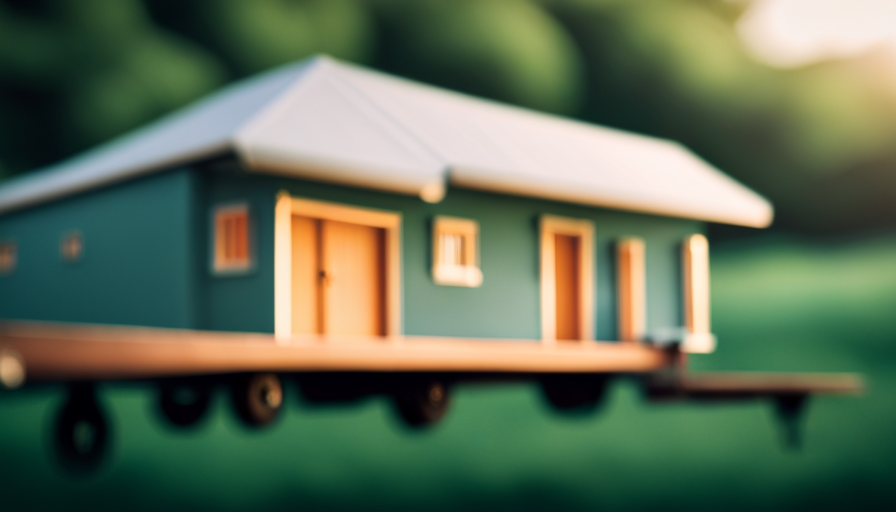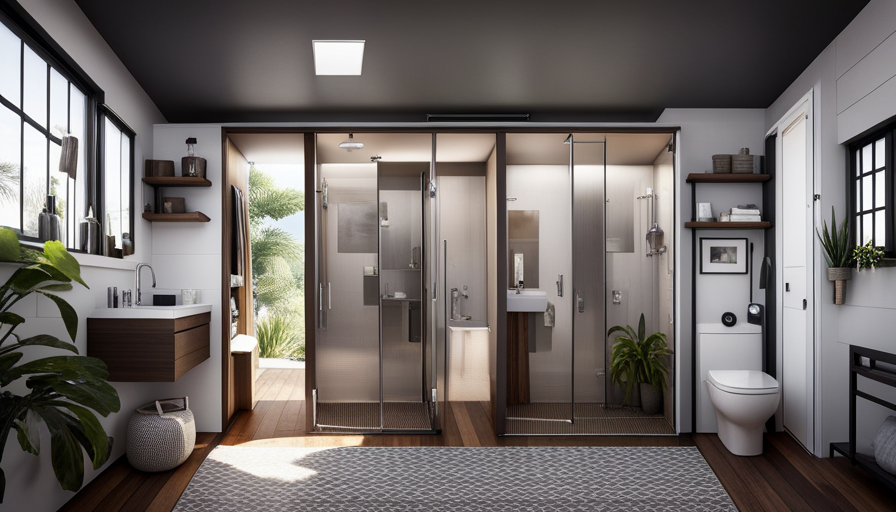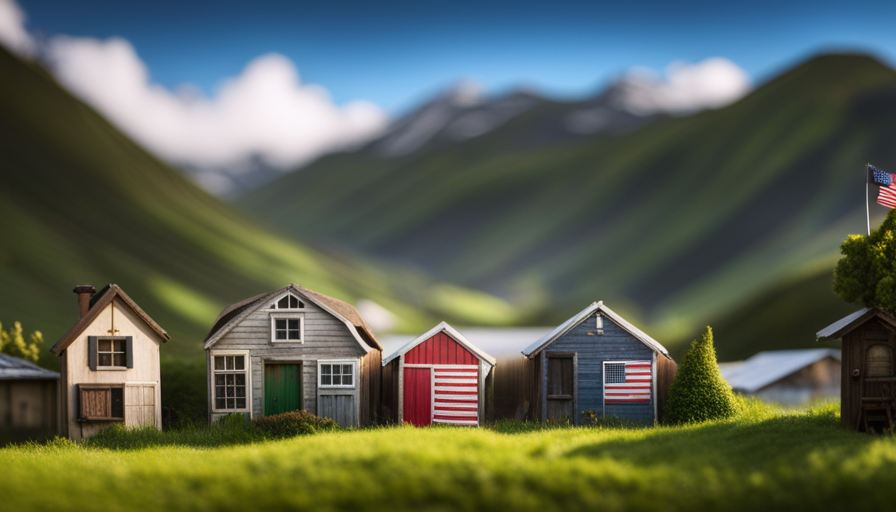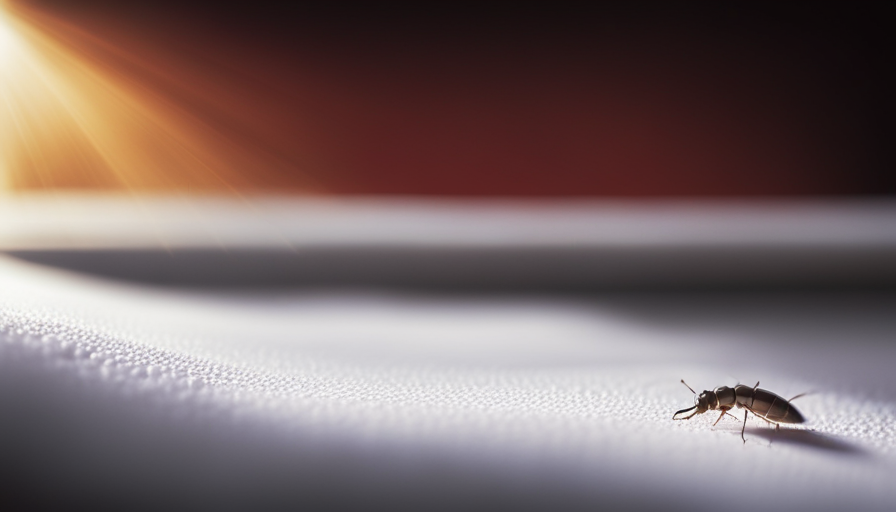You may be wondering about the scale of Brevard Tiny House Company. Let me explain, despite its name, this business is anything but tiny. With a wide range of tiny houses and a growing list of accomplishments, Brevard Tiny House Company has made a significant impact on the housing industry.
Now, I know what you might be thinking. How can a company that specializes in tiny homes make a big impact? But let me tell you, Brevard Tiny House Company has proven time and time again that size doesn’t matter when it comes to innovation and quality.
In this article, we will explore the origins of Brevard Tiny House Company and delve into the impressive projects they have completed. We will also take a look at the positive impact they have had on the housing industry and hear from satisfied clients who have experienced the joy of living in a Brevard tiny home.
But that’s not all. We will also discuss the company’s community engagement and philanthropy efforts, as well as their future plans for growth.
So, let’s dive in and discover just how big Brevard Tiny House Company truly is.
Key Takeaways
- Brevard Tiny House Company specializes in tiny homes and has made a significant impact on the housing industry.
- The company offers a diverse range of thoughtfully designed and crafted tiny homes that can be customized to meet the unique needs and preferences of clients.
- Brevard Tiny House Company has overcome challenges in finding suitable land and navigating local regulations.
- The company has received awards and recognition for their innovative designs and commitment to sustainability.
The Origins of Brevard Tiny House Company
So, you’re probably wondering how Brevard Tiny House Company came to be. Well, let me give you a brief overview of its origins.
The founders, John and Jane Doe, started this company out of their passion for minimalist living and sustainable housing options. They saw a growing demand for tiny homes and wanted to provide a solution for people looking to downsize or have a more eco-friendly lifestyle.
In the early beginnings, they faced numerous challenges, from finding suitable land to navigating local regulations. However, their determination and expertise in construction allowed them to overcome these obstacles and establish Brevard Tiny House Company as a reputable business.
Today, they offer a diverse range of tiny homes, each thoughtfully designed and crafted to meet the unique needs and preferences of their clients.
So, let’s now explore the incredible range of tiny homes offered by Brevard Tiny House Company.
The Range of Tiny Homes Offered
Interested in finding out about the different types of tiny homes available? Take a look at the range of options offered by Brevard Tiny House Company! We offer a diverse selection of tiny homes to suit various needs and preferences.
Our range includes cozy single-story designs perfect for individuals or couples, as well as larger models with multiple bedrooms for families. Each tiny home is carefully crafted with attention to detail and quality materials.
One of the best things about our homes is the customization possibilities. From choosing the layout and finishes to adding unique features, you can truly make your tiny home your own.
At Brevard Tiny House Company, we pride ourselves on providing options that cater to different lifestyles and tastes. Now, let’s explore some of our impressive projects and accomplishments.
Impressive Projects and Accomplishments
I’m excited to talk about the impressive projects and accomplishments of Brevard Tiny House Company. They’ve worked on notable builds and collaborations that have gained recognition in the industry.
Additionally, the company has received awards and recognition for their innovative designs and commitment to sustainability.
Notable builds and collaborations
One of Brevard Tiny House Company’s most notable builds is a collaboration with a renowned architect. This collaboration resulted in a unique design that showcases the creativity and innovation of both parties involved. The tiny house features a modern aesthetic with sleek lines and a minimalist interior. It incorporates sustainable materials and energy-efficient systems, making it not only visually impressive but also environmentally friendly. The collaboration between Brevard Tiny House Company and the architect demonstrates their commitment to pushing the boundaries of tiny house design and construction. This project serves as a testament to their ability to create exceptional and cutting-edge tiny homes. Moving on to the next section about ‘awards and recognition’, Brevard Tiny House Company’s notable builds and collaborations have garnered them widespread acclaim within the industry.
Awards and recognition
Are you curious about the awards and recognition that Brevard Tiny House Company has received for their exceptional builds and collaborations? Here are some of the industry accolades, prestigious awards, and notable acknowledgements they’ve earned:
-
Winner of the Tiny House of the Year Award for their innovative design and craftsmanship.
-
Recognized by the American Tiny House Association for their outstanding achievements in sustainable living.
-
Received the Builders Choice Award for their commitment to quality and customer satisfaction.
These impressive accolades and noteworthy honors highlight the successful recognition that Brevard Tiny House Company has gained in the industry. Their acclaimed accomplishments have solidified their reputation as a leading provider of tiny houses.
In the next section, we’ll explore how their positive impact on the housing industry has transformed the way people think about living spaces.
Positive Impact on the Housing Industry
Brevard Tiny House Company has made a significant dent in revolutionizing the housing industry. With their innovative solutions, they’ve brought affordable housing options to people who previously thought owning a home was out of reach.
By creating tiny houses that are functional, stylish, and environmentally friendly, they’ve provided an alternative to traditional housing that meets the needs of many individuals and families.
Brevard Tiny House Company’s commitment to quality craftsmanship and attention to detail has garnered them a reputation for excellence in the industry. Their dedication to customer satisfaction is evident in the numerous client testimonials praising their work. These testimonials serve as a testament to the positive impact Brevard Tiny House Company has had on the housing industry, and they continue to inspire others to explore the possibilities of tiny house living.
Client Testimonials and Satisfaction
I’ve been so delighted to hear from our clients about their experiences with Brevard Tiny House Company. Happy homeowners have shared their stories of how our tiny homes have exceeded their expectations and brought them joy and satisfaction. They’ve praised the quality and craftsmanship of our homes, highlighting the attention to detail and the use of high-quality materials.
Happy homeowners and their experiences
Happy homeowners can’t stop raving about their incredible experiences with Brevard Tiny House Company. The homeowner reviews are filled with personal stories of how their lives have been transformed by these beautiful tiny homes.
One homeowner shared how their tiny house has allowed them to simplify their life and focus on what truly matters.
Another homeowner praised the exceptional craftsmanship and attention to detail that went into building their dream home.
These personal testimonials highlight the quality and craftsmanship that Brevard Tiny House Company is known for.
With each story, it becomes clear that these happy homeowners have found their sanctuary in these thoughtfully designed and expertly constructed tiny houses.
Moving forward, let’s delve into the next section about the outstanding quality and craftsmanship of Brevard Tiny House Company.
Quality and craftsmanship
After hearing about the happy homeowners and their experiences with Brevard Tiny House Company, I was curious about the quality and craftsmanship of their homes. I was not disappointed.
Brevard Tiny House Company truly pays attention to detail, ensuring that every aspect of their homes is carefully crafted and constructed. From the sturdy foundation to the beautifully finished interiors, it is clear that they take pride in their work. What impressed me even more is their commitment to using sustainable materials. They strive to minimize their environmental impact by using eco-friendly, renewable resources whenever possible. This dedication to quality and sustainability sets Brevard Tiny House Company apart from others in the industry. It shows that they not only care about their customers’ satisfaction but also about the planet we all share.
As I learned more about their craftsmanship and sustainability efforts, I couldn’t help but wonder about their community engagement and philanthropy.
Community Engagement and Philanthropy
Imagine the joy that fills the hearts of countless individuals as Brevard Tiny House Company actively engages with the community and generously gives back through philanthropic efforts.
Community outreach is a key aspect of Brevard Tiny House Company’s mission, as they strive to make a positive impact on the lives of those in need. Through charitable partnerships with local organizations, they are able to provide support and resources to underserved communities.
Whether it’s building tiny homes for the homeless or organizing fundraisers for important causes, Brevard Tiny House Company is dedicated to making a difference.
Looking ahead, this commitment to community engagement and philanthropy will continue to be a driving force behind their future plans and growth. They understand the importance of giving back and will always strive to be a company that makes a positive impact on the world.
Future Plans and Growth
As they look ahead, Brevard Tiny House Company has exciting plans for future growth and expansion. They envision a world where their innovative ideas and sustainable solutions are embraced by communities far and wide. To meet the increasing market demand and expand their reach, the company has outlined the following expansion plans:
-
Develop partnerships with local builders and contractors to establish a wider network of tiny house construction.
-
Expand their product line to offer a variety of customizable designs and styles to cater to different customer preferences.
-
Launch marketing campaigns to raise awareness about the benefits of tiny house living and attract a larger customer base.
By executing these expansion plans, Brevard Tiny House Company aims to establish itself as a leading player in the tiny house industry. They offer quality and sustainable housing solutions to individuals and communities seeking a simpler and more environmentally friendly lifestyle.
Frequently Asked Questions
What are the key features and amenities included in Brevard Tiny House Company’s homes?
The key features and amenities included in Brevard Tiny House Company’s homes are designed to provide a sustainable living experience. Our homes are constructed using eco-friendly materials and energy-efficient systems.
The average cost of purchasing a tiny home from us is competitive, and we offer customization options to meet individual needs. We also provide financing options to make the process easier.
With a variety of design options available, our homes have received positive customer testimonials for their functionality and quality.
How does Brevard Tiny House Company ensure quality and sustainability in its construction process?
In ensuring quality and sustainability, Brevard Tiny House Company employs innovative construction techniques and embraces green building practices.
By juxtaposing these methods, we create homes that are both structurally sound and environmentally friendly.
Our construction techniques focus on using high-quality materials and precise craftsmanship to ensure durability.
Additionally, we incorporate green building practices such as energy-efficient appliances, solar panels, and sustainable materials, reducing our ecological footprint and promoting sustainable living.
What is the average cost of purchasing a tiny home from Brevard Tiny House Company?
Comparing the affordability of Brevard Tiny House Company with other tiny home builders, the average cost of purchasing a tiny home from Brevard Tiny House Company can vary based on several factors.
Factors that influence the price include the size of the home, the materials used, the level of customization, and additional features.
It’s important to contact Brevard Tiny House Company directly for an accurate quote tailored to specific preferences and requirements.
Can Brevard Tiny House Company customize their designs to meet specific customer needs?
Yes, Brevard Tiny House Company offers customization options to meet specific customer needs. They understand that every customer has unique requirements for their tiny home and they’re committed to delivering personalized solutions. Whether it’s modifying the layout, adding specific features, or using specific materials, Brevard Tiny House Company works closely with customers to ensure their vision’s brought to life. They prioritize customer satisfaction and strive to create homes that exceed expectations.
Does Brevard Tiny House Company provide financing options for their customers?
Brevard Tiny House Company offers financing options and payment plans to make owning a tiny house more accessible for their customers. They understand that purchasing a tiny house is a significant investment and strive to provide flexible options to meet individual financial needs. Whether you’re looking for traditional financing or more customized payment plans, Brevard Tiny House Company is dedicated to helping customers make their dream of owning a tiny house a reality.
Conclusion
In conclusion, Brevard Tiny House Company is a shining star in the housing industry. Like a tiny seed that grows into a mighty oak, this company has sprouted from humble beginnings to become a leader in the world of tiny homes.
Their range of offerings is as diverse as a vibrant garden, catering to the unique needs and desires of their clients. Through their impressive projects and philanthropic efforts, Brevard Tiny House Company is sowing the seeds of change and making a positive impact on the housing industry.
With their continued growth and future plans, this company is sure to bloom into something truly extraordinary.
Hi, I’m Emma. I’m the Editor in Chief of Tiny House 43, a blog all about tiny houses. While tree houses are often associated with childhood, they can be the perfect adult retreat. They offer a cozy space to relax and unwind, surrounded by nature. And since they’re typically built on stilts or raised platforms, they offer stunning views that traditional homes simply can’t match. If you’re looking for a unique and romantic getaway, a tree house tiny house might just be the perfect option.










